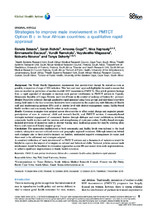Strategies to improve male involvement in PMTCT Option B+ in four African countries: a qualitative rapid appraisal
Date
2016Author
Besada, Donela
Rohde, Sarah
Goga, Ameena
Raphaely, Nika
Daviaud, Emmanuelle
Ramokolo, Vundli
Magasana, Vuyolwethu
Noveve, Nobuntu
Doherty, Tanya
Metadata
Show full item recordAbstract
BACKGROUND: The World Health Organization recommends that antiretroviral therapy be started as soon as
possible, irrespective of stage of HIV infection. This ‘test and treat’ approach highlights the need to ensure that
men are involved in prevention of mother-to-child HIV transmission (PMTCT). This article presents findings
from a rapid appraisal of strategies to increase male partner involvement in PMTCT services in Uganda,
Democratic Republic of Congo, Malawi, and Coˆ te d’Ivoire in the context of scale-up of Option B protocol.
DESIGN: Data were collected through qualitative rapid appraisal using focus groups and individual interviews
during field visits to the four countries. Interviews were conducted in the capital city with Ministry of Health
staff and implementing partners (IPs) and at district level with district management teams, facility-based
health workers and community health cadres in each country.
RESULTS: Common strategies were adopted across the countries to effect social change and engender greater
participation of men in maternal, child and women’s health, and PMTCT services. Community-based
strategies included engagement of community leaders through dialogue and social mobilization, involving
community health workers and the creation and strengthening of male peer cadres. Facility-based strategies
included provision of incentives such as shorter waiting time, facilitating access for men by altering clinic
hours, and creation of family support groups.
CONCLUSIONS: The approaches implemented at both community and facility levels were tailored to the local
context, taking into account cultural norms and geographic regional variations. Although intentions behind
such strategies aim to have positive impacts on families, unintended negative consequences do occur, and
these need to be addressed and strategies adapted.
A consistent definition of ‘male involvement’ in PMTCT services and a framework of indicators would be
helpful to capture the impact of strategies on cultural and behavioral shifts. National policies around male
involvement would be beneficial to streamline approaches across IPs and ensure wide-scale implementation,
to achieve significant improvements in family health outcomes.

